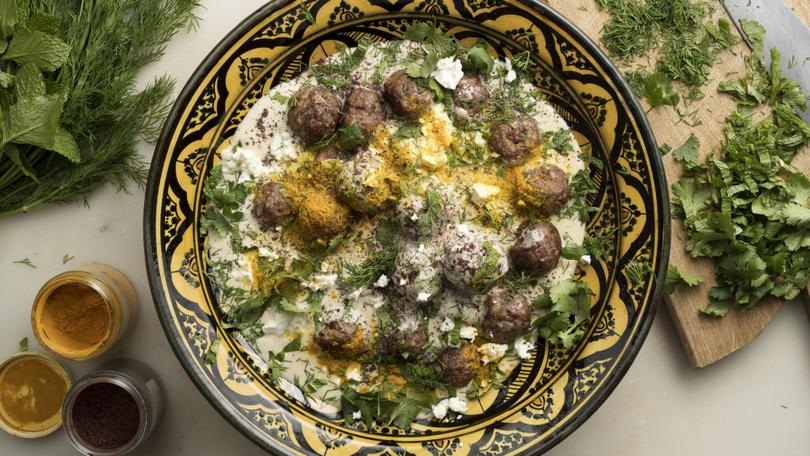Meatballs With a Bounce of Turkish Zeal

What kind of meatballs are these? It’s a fair question: Meatballs come in countless variations. You could make them every week for a year, never repeating a recipe. It is a culinary common thread that runs through albondigas, polpettini, boulettes, kofte — all spherical morsels of finely chopped meat.
The origin of the meatball is hardly a mystery. When an animal is butchered, there are a limited number of primal cuts, the tender parts that are turned into chops, steaks and roasts. The rest of the beast is used for stewing or put through the meat grinder to become burgers, sausages, meatloaf or meatballs. For many cooks and diners, the bite-size meatball is the most appealing.
All meatballs begin the same way. Freshly ground meat is mixed with seasonings and a bit of bread or rice before being rolled into balls. (Nearly all recipes advise forming them with wet hands.) They are then browned on the stovetop or in the oven, to be eaten as is, simmered in a sauce or added to a soup.
Sign up to The Nightly's newsletters.
Get the first look at the digital newspaper, curated daily stories and breaking headlines delivered to your inbox.
By continuing you agree to our Terms and Privacy Policy.This recipe, made with ground lamb, has a Turkish feel, spiced with cumin, coriander, cinnamon and a touch of cayenne. The meatballs are browned in olive oil — though flattening them into patties to be griddled or grilled would be another good choice — and served with a traditional yoghurt sauce.
Some cooks braise their meatballs after browning, which renders them exceedingly moist, soft and tender. In this rendition, I like them straight out of the frying pan, crisp on the outside and juicy inside.
The warm, tart yoghurt sauce adds tang and richness, especially when made with whole-milk yoghurt. It is prepared at the last minute, just before serving. A beaten egg and a little cornstarch are added to prevent the yoghurt from curdling when heated.
Don’t bathe them in the sauce. Instead, pile the meatballs on a platter and pour the sauce over them. For more flavour and visual appeal, add crumbled feta, and sprinkle with sour sumac powder and crushed red-pepper flakes. (Turkish Aleppo pepper is delicious and not too spicy. Korean red-pepper flakes are a good substitute.)
To finish, give it all a shower of chopped mint, cilantro and dill. Pinches of bright yellow turmeric to finish make the dish a showstopper.
Spiced Lamb Meatballs With Yoghurt and Herbs
Ingredients:
680g ground lamb, not too lean (from a cut like shoulder or breast, not leg)
½ cup breadcrumbs
2 tsp kosher/cooking salt
½ tsp black pepper
½ cup finely diced red onion
1 tsp toasted ground cumin
1 tsp toasted ground coriander
¼ teaspoon cinnamon
Pinch of cayenne
3 eggs
Extra-virgin olive oil
1 cup chicken broth
1 cup plain, very tart yoghurt (if using Greek-style yoghurt, thin it with milk and lemon juice)
1 tbsp cornstarch, dissolved in 2 tbsp water
55g crumbled feta cheese
½ tsp sumac
Crushed red-pepper flakes, to taste
Turmeric, for garnish (optional)
3 tbsp chopped mint
2 tbsp chopped dill
Coriander sprigs
Preparation:
Step 1 In a large bowl, use your hands to combine lamb, breadcrumbs, salt, pepper, onion, cumin, ground coriander, cinnamon and cayenne. Beat 2 of the eggs and add to meat, mixing until incorporated. Cover and refrigerate for 30 minutes to 24 hours to allow the seasonings to permeate the meat.
Step 2 Using wet hands, break off walnut-sized pieces of lamb mixture, roll into spheres and set aside on a baking sheet. You should have about 30 meatballs.
Step 3 Heat oven to 110C. In a large skillet/frying pan, heat 2 tablespoons oil over medium-high heat. When shimmering, add meatballs in one layer and brown for 2-3 minutes. Turn and cook for 4-5 minutes more. (Work in batches, if necessary, to avoid crowding the pan.) Transfer to a paper towel-lined baking sheet to blot any extra oil, then pile meatballs on a heatproof serving platter and keep warm in the oven.
Step 4 Pour off any excess oil from frying pan and turn heat to high. Add broth and bring to a simmer. In a bowl, whisk together yoghurt; ½ teaspoon salt; remaining egg, beaten; and cornstarch. Pour yoghurt mixture in a thin stream into the hot broth, whisking constantly. Turn heat down slightly and continue whisking until yoghurt is heated through and slightly thickened, about 1 minute. Do not let mixture boil.
Step 5 Pour hot yoghurt sauce over meatballs. Sprinkle crumbled feta, sumac and crushed red pepper on top. Finish with pinches of turmeric, if using, and sprinkle with mint, dill and cilantro. Serve immediately with rice, orzo, pita bread or potatoes.
Serves 5-6
Total time: 1 hour
© 2024 The New York Times Company
